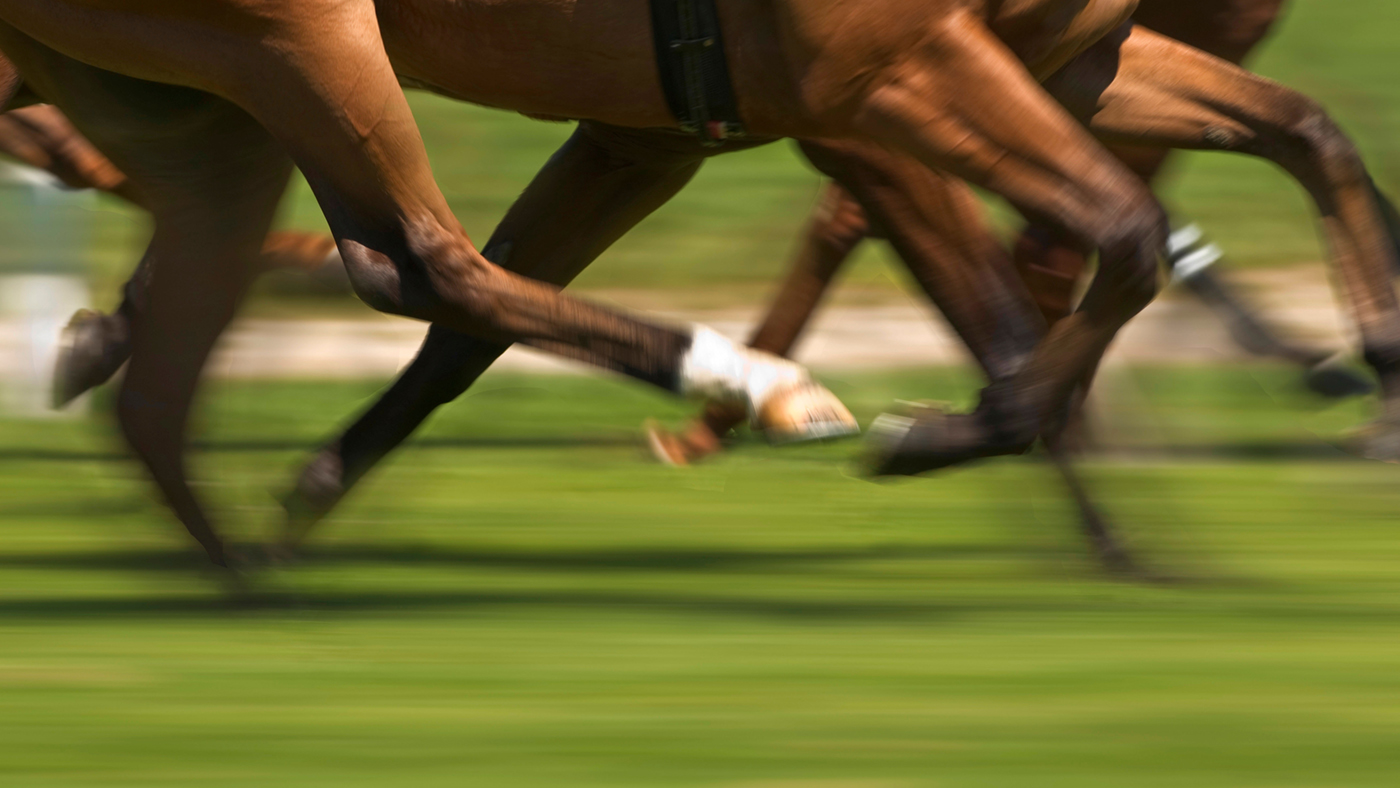Even forage and pasture can contribute to an excess of sugar and starch, triggering a cascade of health problems. David Rendle FRCVS offers dietary advice
HORSES evolved on pastures that were high in fibre and low in sugar and starch. As a result, they have adapted to meet most of their energy requirements by fermenting grasses and other plants to release the energy contained within the plants’ fibrous structure.
By harnessing the ability of bacteria to ferment fibre, horses are able to satisfy their nutritional needs through the ingestion of forage alone. With domestication, however, it has become commonplace to increase their energy intake through supplementation with feeds high in sugars and starches.
Feeding energy-dense cereals was more convenient and practical than large volumes of forage, particularly when horses worked long hours, under heavy loads, in urban environments. These days, only horses performing extreme levels of exercise require supplementary feeds high in sugar and starch.
{"content":"PHA+RXNjYWxhdGluZyBsZXZlbHMgb2YgZXF1aW5lIG9iZXNpdHkgZGVtb25zdHJhdGUgd2UgYXJlIGZhaWxpbmcgdG8gYmFsYW5jZSBlbmVyZ3kgcmVxdWlyZW1lbnRzIHdpdGggZmVlZC4gSXQgaXMgZXN0aW1hdGVkIHRoYXQgYXJvdW5kIDUwJSBvZiBob3JzZXMgaW4gdGhlIFVLIGFyZSB2ZXJ5IG92ZXJ3ZWlnaHQgb3Igb2Jlc2UuPC9wPgo8cD5XaGVuIGEgaG9yc2XigJlzIGVuZXJneSBpbnRha2UgZXhjZWVkcyB3aGF0IGhlIHJlcXVpcmVzIHRvIHJlbWFpbiBoZWFsdGh5IGFuZCB0byBleGVyY2lzZSwgdGhlIHN1cnBsdXMgaXMgY29udmVydGVkIHRvIGZhdC4gSW4gYWRkaXRpb24gdG8gcHJvdmlkaW5nIGEgbWVhbnMgb2Ygc3RvcmluZyBlbmVyZ3ksIGZhdCBwcm9kdWNlcyDigJxzaWduYWxsaW5nIG1vbGVjdWxlc+KAnSB0aGF0IGFsdGVyIHRoZSBtZXRhYm9saXNtIOKAkyB3aXRoIHRoZSBtb3N0IG5vdGFibGUgY2hhbmdlIGJlaW5nIGEgcmVkdWN0aW9uIGluIHRoZSByZXNwb25zaXZlbmVzcyB0byBpbnN1bGluLjwvcD4KPHA+PGRpdiBjbGFzcz0iYWQtY29udGFpbmVyIGFkLWNvbnRhaW5lci0tbW9iaWxlIj48ZGl2IGlkPSJwb3N0LWlubGluZS0yIiBjbGFzcz0iaXBjLWFkdmVydCI+PC9kaXY+PC9kaXY+PHNlY3Rpb24gaWQ9ImVtYmVkX2NvZGUtMzEiIGNsYXNzPSJoaWRkZW4tbWQgaGlkZGVuLWxnIHMtY29udGFpbmVyIHN0aWNreS1hbmNob3IgaGlkZS13aWRnZXQtdGl0bGUgd2lkZ2V0X2VtYmVkX2NvZGUgcHJlbWl1bV9pbmxpbmVfMiI+PHNlY3Rpb24gY2xhc3M9InMtY29udGFpbmVyIGxpc3RpbmctLXNpbmdsZSBsaXN0aW5nLS1zaW5nbGUtc2hhcmV0aHJvdWdoIGltYWdlLWFzcGVjdC1sYW5kc2NhcGUgZGVmYXVsdCBzaGFyZXRocm91Z2gtYWQgc2hhcmV0aHJvdWdoLWFkLWhpZGRlbiI+DQogIDxkaXYgY2xhc3M9InMtY29udGFpbmVyX19pbm5lciI+DQogICAgPHVsPg0KICAgICAgPGxpIGlkPSJuYXRpdmUtY29udGVudC1tb2JpbGUiIGNsYXNzPSJsaXN0aW5nLWl0ZW0iPg0KICAgICAgPC9saT4NCiAgICA8L3VsPg0KICA8L2Rpdj4NCjwvc2VjdGlvbj48L3NlY3Rpb24+PC9wPgo8cD5Nb3JlIGluc3VsaW4gbXVzdCB0aGVuIGJlIHByb2R1Y2VkIHRvIGNvbXBlbnNhdGUsIGluY3JlYXNpbmcgdGhlIHJpc2sgb2YgbGFtaW5pdGlzLiBUaGlzIGNvbWJpbmF0aW9uIG9mIG9iZXNpdHksIHJlZHVjdGlvbiBpbiBzZW5zaXRpdml0eSB0byBpbnN1bGluIGFuZCBhbiBpbmNyZWFzZWQgbGFtaW5pdGlzIHJpc2sgaGFzIGJlY29tZSBrbm93biBhcyBlcXVpbmUgbWV0YWJvbGljIHN5bmRyb21lIChFTVMpLjwvcD4KPHA+T2Jlc2l0eSBpcyBhc3NvY2lhdGVkIHdpdGggbWFueSBvdGhlciBoZWFsdGggcHJvYmxlbXMsIGluY2x1ZGluZyBvcnRob3BhZWRpYyBkaXNlYXNlLCBhY2NlbGVyYXRlZCBhZ2VpbmcsIGRldmVsb3BtZW50YWwgcHJvYmxlbXMgaW4geW91bmdzdG9jaywgY29saWMgYW5kIHBvb3IgcGVyZm9ybWFuY2UuIEZlZWRpbmcgZXhjZXNzIHN1Z2FyIGFuZCBzdGFyY2ggY2FuIGRpc3J1cHQgbm9ybWFsIGJhY3RlcmlhbCBmZXJtZW50YXRpb24gaW4gdGhlIGxhcmdlIGludGVzdGluZSwgcmVzdWx0aW5nIGluIGNvbWJpbmF0aW9ucyBvZiBjb2xpdGlzLCBsYW1pbml0aXMgYW5kIHRoZSBzeXN0ZW1pYyBkaXNvcmRlciBlbmRvdG94YWVtaWEuIFN0YXJjaGVzIGFsc28gaW5jcmVhc2UgdGhlIHByb2R1Y3Rpb24gb2YgYWNpZCBpbiB0aGUgc3RvbWFjaCwgaW5jcmVhc2luZyB0aGUgcmlzayBvZiBnYXN0cmljIHVsY2Vycy48L3A+CjxwPjxkaXYgaWQ9ImF0dGFjaG1lbnRfNzQzNTA3IiBzdHlsZT0id2lkdGg6IDE0MTBweCIgY2xhc3M9IndwLWNhcHRpb24gYWxpZ25ub25lIj48aW1nIGZldGNocHJpb3JpdHk9ImhpZ2giIGRlY29kaW5nPSJhc3luYyIgYXJpYS1kZXNjcmliZWRieT0iY2FwdGlvbi1hdHRhY2htZW50LTc0MzUwNyIgY2xhc3M9Imxhenlsb2FkIGJsdXItdXAgc2l6ZS1mdWxsIHdwLWltYWdlLTc0MzUwNyIgZGF0YS1wcm9jZXNzZWQgc3JjPSJodHRwczovL2tleWFzc2V0cy50aW1laW5jdWsubmV0L2luc3BpcmV3cC9saXZlL3dwLWNvbnRlbnQvdXBsb2Fkcy9zaXRlcy8xNC8yMDE3LzAzL25ldy1oaC1wbGFjZWhvbGRlci0yMDB4MjAwLnBuZyIgZGF0YS1zcmM9Imh0dHBzOi8va2V5YXNzZXRzLnRpbWVpbmN1ay5uZXQvaW5zcGlyZXdwL2xpdmUvd3AtY29udGVudC91cGxvYWRzL3NpdGVzLzE0LzIwMjEvMDQvSEFIMzAyLnZldF8ud2VpZ2hpbmdfaGF5XzNfNDA5MDQ3NjcyXzczNjI0OTgyMl90aV9hcmNoaXZlLmpwZyIgYWx0PSIiIHdpZHRoPSIxNDAwIiBoZWlnaHQ9IjE5MDAiIGRhdGEtc2l6ZXM9ImF1dG8iIGRhdGEtc3Jjc2V0PSJodHRwczovL2tleWFzc2V0cy50aW1laW5jdWsubmV0L2luc3BpcmV3cC9saXZlL3dwLWNvbnRlbnQvdXBsb2Fkcy9zaXRlcy8xNC8yMDIxLzA0L0hBSDMwMi52ZXRfLndlaWdoaW5nX2hheV8zXzQwOTA0NzY3Ml83MzYyNDk4MjJfdGlfYXJjaGl2ZS5qcGcgMTQwMHcsIGh0dHBzOi8va2V5YXNzZXRzLnRpbWVpbmN1ay5uZXQvaW5zcGlyZXdwL2xpdmUvd3AtY29udGVudC91cGxvYWRzL3NpdGVzLzE0LzIwMjEvMDQvSEFIMzAyLnZldF8ud2VpZ2hpbmdfaGF5XzNfNDA5MDQ3NjcyXzczNjI0OTgyMl90aV9hcmNoaXZlLTE0N3gyMDAuanBnIDE0N3csIGh0dHBzOi8va2V5YXNzZXRzLnRpbWVpbmN1ay5uZXQvaW5zcGlyZXdwL2xpdmUvd3AtY29udGVudC91cGxvYWRzL3NpdGVzLzE0LzIwMjEvMDQvSEFIMzAyLnZldF8ud2VpZ2hpbmdfaGF5XzNfNDA5MDQ3NjcyXzczNjI0OTgyMl90aV9hcmNoaXZlLTI5NXg0MDAuanBnIDI5NXcsIGh0dHBzOi8va2V5YXNzZXRzLnRpbWVpbmN1ay5uZXQvaW5zcGlyZXdwL2xpdmUvd3AtY29udGVudC91cGxvYWRzL3NpdGVzLzE0LzIwMjEvMDQvSEFIMzAyLnZldF8ud2VpZ2hpbmdfaGF5XzNfNDA5MDQ3NjcyXzczNjI0OTgyMl90aV9hcmNoaXZlLTc0eDEwMC5qcGcgNzR3LCBodHRwczovL2tleWFzc2V0cy50aW1laW5jdWsubmV0L2luc3BpcmV3cC9saXZlL3dwLWNvbnRlbnQvdXBsb2Fkcy9zaXRlcy8xNC8yMDIxLzA0L0hBSDMwMi52ZXRfLndlaWdoaW5nX2hheV8zXzQwOTA0NzY3Ml83MzYyNDk4MjJfdGlfYXJjaGl2ZS0xMTMyeDE1MzYuanBnIDExMzJ3LCBodHRwczovL2tleWFzc2V0cy50aW1laW5jdWsubmV0L2luc3BpcmV3cC9saXZlL3dwLWNvbnRlbnQvdXBsb2Fkcy9zaXRlcy8xNC8yMDIxLzA0L0hBSDMwMi52ZXRfLndlaWdoaW5nX2hheV8zXzQwOTA0NzY3Ml83MzYyNDk4MjJfdGlfYXJjaGl2ZS0yMzZ4MzIwLmpwZyAyMzZ3LCBodHRwczovL2tleWFzc2V0cy50aW1laW5jdWsubmV0L2luc3BpcmV3cC9saXZlL3dwLWNvbnRlbnQvdXBsb2Fkcy9zaXRlcy8xNC8yMDIxLzA0L0hBSDMwMi52ZXRfLndlaWdoaW5nX2hheV8zXzQwOTA0NzY3Ml83MzYyNDk4MjJfdGlfYXJjaGl2ZS00NTd4NjIwLmpwZyA0NTd3LCBodHRwczovL2tleWFzc2V0cy50aW1laW5jdWsubmV0L2luc3BpcmV3cC9saXZlL3dwLWNvbnRlbnQvdXBsb2Fkcy9zaXRlcy8xNC8yMDIxLzA0L0hBSDMwMi52ZXRfLndlaWdoaW5nX2hheV8zXzQwOTA0NzY3Ml83MzYyNDk4MjJfdGlfYXJjaGl2ZS02Nzh4OTIwLmpwZyA2Nzh3LCBodHRwczovL2tleWFzc2V0cy50aW1laW5jdWsubmV0L2luc3BpcmV3cC9saXZlL3dwLWNvbnRlbnQvdXBsb2Fkcy9zaXRlcy8xNC8yMDIxLzA0L0hBSDMwMi52ZXRfLndlaWdoaW5nX2hheV8zXzQwOTA0NzY3Ml83MzYyNDk4MjJfdGlfYXJjaGl2ZS04OTl4MTIyMC5qcGcgODk5dywgaHR0cHM6Ly9rZXlhc3NldHMudGltZWluY3VrLm5ldC9pbnNwaXJld3AvbGl2ZS93cC1jb250ZW50L3VwbG9hZHMvc2l0ZXMvMTQvMjAyMS8wNC9IQUgzMDIudmV0Xy53ZWlnaGluZ19oYXlfM180MDkwNDc2NzJfNzM2MjQ5ODIyX3RpX2FyY2hpdmUtMTE5NHgxNjIwLmpwZyAxMTk0dyIgc2l6ZXM9IihtYXgtd2lkdGg6IDE0MDBweCkgMTAwdncsIDE0MDBweCIgLz48cCBpZD0iY2FwdGlvbi1hdHRhY2htZW50LTc0MzUwNyIgY2xhc3M9IndwLWNhcHRpb24tdGV4dCI+V2VpZ2hpbmcgaGF5PC9wPjwvZGl2PjxiciAvPgo8ZGl2IGNsYXNzPSJhZC1jb250YWluZXIgYWQtY29udGFpbmVyLS1tb2JpbGUiPjxkaXYgaWQ9InBvc3QtaW5saW5lLTMiIGNsYXNzPSJpcGMtYWR2ZXJ0Ij48L2Rpdj48L2Rpdj48L3A+CjxoMz5QQVNUVVJFIFBFUklMUzwvaDM+CjxwPlRIRSBzaW1wbGVzdCBtZWFucyBvZiByZWR1Y2luZyBhIGhvcnNl4oCZcyBlbmVyZ3kgaW50YWtlIGlzIHRvIGZlZWQgaGltIHNvbGVseSBmb3JhZ2UsIHdpdGggYW4gYWRkaXRpb25hbCB2aXRhbWluIGFuZCBtaW5lcmFsIGJhbGFuY2VyLiBJbiBmYXZvdXJhYmxlIGNvbmRpdGlvbnMsIGhvd2V2ZXIsIDMwJSBvZiB0aGUgd2VpZ2h0IG9mIHNvbWUgZ3Jhc3NlcyBtYXkgYmUgc3VnYXJzIGFuZCBzdGFyY2hlcyDigJMgbWVhbmluZyB0aGF0IHRoZWlyIGVuZXJneSBjb250ZW50IGlzIHNpbWlsYXIgdG8gdGhhdCBvZiBzb21lIGNlcmVhbC1iYXNlZCBmZWVkcy4gV2hpbGUgZWxpbWluYXRpbmcgY2VyZWFsLWJhc2VkIGZlZWQgaXMgYSBnb29kIHN0YXJ0IHRvIHJlZHVjaW5nIHN1Z2FyIGludGFrZSwgZm9yIG1vc3QgaG9yc2VzIHRoaXMgaXMgbm90IGVub3VnaCB0byBwcmV2ZW50IHdlaWdodCBnYWluLjwvcD4KPHA+VGhlIHN1Z2FyIGFuZCBzdGFyY2ggY29udGVudCBvZiBncmFzcyB2YXJpZXMgZHJhbWF0aWNhbGx5LCBzbyBjb25zaWRlcmF0aW9uIG11c3QgYmUgZ2l2ZW4gdG8gdGhlIHF1YW50aXR5IGFuZCB0eXBlIG9mIGdyYXppbmcgb3IgZm9yYWdlIHRoYXQgaXMgYmVpbmcgZmVkLiBMZXZlbHMgb2Ygc3VnYXIgYW5kIHN0YXJjaCBpbiBncmFzcyBhcmUgYXQgdGhlaXIgaGlnaGVzdDo8L3A+CjxkaXYgY2xhc3M9ImFkLWNvbnRhaW5lciBhZC1jb250YWluZXItLW1vYmlsZSI+PGRpdiBpZD0icG9zdC1pbmxpbmUtNCIgY2xhc3M9ImlwYy1hZHZlcnQiPjwvZGl2PjwvZGl2Pgo8dWw+CjxsaT5JbiBwYXN0dXJlcyBvZiBjdWx0aXZhdGVkIChyYXRoZXIgdGhhbiBuYXRpdmUpIGdyYXNzIHNwZWNpZXMsIHN1Y2ggYXMgcnllZ3Jhc3Nlcywgd2hpY2ggd2VyZSBkZXZlbG9wZWQgdG8gbWF4aW1pc2UgcHJvZHVjdGlvbiBpbiB0aGUgbGl2ZXN0b2NrIGluZHVzdHJ5LiBXaGlsZSBncmFzcyBzaG91bGQgYmUga2VwdCBoZWFsdGh5LCBmZXJ0aWxpc2VycyB3aWxsIGluY3JlYXNlIHZvbHVtZS48L2xpPgo8bGk+RHVyaW5nIGNvbmRpdGlvbnMgb2YgcGxhbnQgZ3Jvd3RoLCB3aGVuIHN1bm55IHdlYXRoZXIgY29tYmluZXMgd2l0aCBzdWZmaWNpZW50IG1vaXN0dXJlLiBHcmFzcyBzZWVkIGhlYWRzIGFyZSBoaWdoIGluIHN0YXJjaCBhbmQgdGhlIHRvdGFsIHN1Z2FyIGFuZCBzdGFyY2ggY29udGVudCB3aWxsIHJlZHVjZSBvbmNlIHRoZSBncmFzcyBoYXMgc2hlZCBzZWVkIGFuZCBiZWNvbWVzIHdvb2R5LjwvbGk+CjxsaT5JbiBzdW5ueSBidXQgY29sZCBvciBmcm9zdHkgd2VhdGhlci48L2xpPgo8bGk+TGF0ZXIgaW4gdGhlIGRheSwgbWVhbmluZyB0aGF0IHR1cm5vdXQgaW4gdGhlIG1vcm5pbmcgaXMgcHJlZmVyYWJsZSB0byB0dXJub3V0IGluIHRoZSBldmVuaW5nLiBUaGUgc3VubmllciB0aGUgd2VhdGhlciwgdGhlIG1vcmUgcmFwaWRseSBzdWdhciBsZXZlbHMgd2lsbCBpbmNyZWFzZTsgaW4gYnJpZ2h0IGNvbmRpdGlvbnMsIGxldmVscyBtYXkgcGVhayBieSBtaWRkYXkuIEdyYXNzIGluIGZ1bGwgc3VuIGlzIGxpa2VseSB0byBoYXZlIGEgaGlnaGVyIHN1Z2FyIGNvbnRlbnQgdGhhbiBncmFzcyBpbiBzaGFkZS48L2xpPgo8bGk+T24gaGVhdmlseSBncmF6ZWQgcGFzdHVyZSBvciBmcmVzaGx5IGN1dCBoYXkgc3R1YmJsZS4gQWx0aG91Z2ggdGhlcmUgd2lsbCBiZSBsZXNzIGdyYXNzIGF2YWlsYWJsZSwgd2hhdCByZW1haW5zIGNhbiBoYXZlIGEgdmVyeSBoaWdoIHN1Z2FyIGNvbnRlbnQuIFJlc3RyaWN0aW5nIHRoZSBpbnRha2Ugb2YgaGVhbHRoeSwgc3RlYWRpbHkgZ3Jvd2luZyBuYXRpdmUgZ3Jhc3MgaXMgcHJlZmVyYWJsZSB0byB1c2luZyBvdmVyZ3JhemVkIG9yIHN0cmVzc2VkIHBhc3R1cmUuPC9saT4KPC91bD4KPHA+V2hpbGUgdGhlc2UgZmFjdG9ycyBhcmUgd29ydGh5IG9mIGNvbnNpZGVyYXRpb24sIHVsdGltYXRlbHkgdGhlIG9ubHkgbWVhbnMgb2YgcmVkdWNpbmcgZW5lcmd5IGludGFrZSB0byBhbiBhcHByb3ByaWF0ZSBsZXZlbCBpbiBhIGhvcnNlIHRoYXQgaXMgb2Jlc2UgaXMgdG8gbGltaXQgaGlzIGFjY2VzcyB0byBwYXN0dXJlLjwvcD4KPHA+PGRpdiBjbGFzcz0iYWQtY29udGFpbmVyIGFkLWNvbnRhaW5lci0tbW9iaWxlIj48ZGl2IGlkPSJwb3N0LWlubGluZS01IiBjbGFzcz0iaXBjLWFkdmVydCI+PC9kaXY+PC9kaXY+PGJyIC8+CjxkaXYgaWQ9ImF0dGFjaG1lbnRfNzQzNTA2IiBzdHlsZT0id2lkdGg6IDE0MTBweCIgY2xhc3M9IndwLWNhcHRpb24gYWxpZ25ub25lIj48aW1nIGRlY29kaW5nPSJhc3luYyIgYXJpYS1kZXNjcmliZWRieT0iY2FwdGlvbi1hdHRhY2htZW50LTc0MzUwNiIgY2xhc3M9Imxhenlsb2FkIGJsdXItdXAgc2l6ZS1mdWxsIHdwLWltYWdlLTc0MzUwNiIgZGF0YS1wcm9jZXNzZWQgc3JjPSJodHRwczovL2tleWFzc2V0cy50aW1laW5jdWsubmV0L2luc3BpcmV3cC9saXZlL3dwLWNvbnRlbnQvdXBsb2Fkcy9zaXRlcy8xNC8yMDE3LzAzL25ldy1oaC1wbGFjZWhvbGRlci0yMDB4MjAwLnBuZyIgZGF0YS1zcmM9Imh0dHBzOi8va2V5YXNzZXRzLnRpbWVpbmN1ay5uZXQvaW5zcGlyZXdwL2xpdmUvd3AtY29udGVudC91cGxvYWRzL3NpdGVzLzE0LzIwMjEvMDQvSEFIMzAyLnZldF8uZmVlZGluZ183XzQwOTAzMzMzMl83MzYyNDk4MjJfdGlfYXJjaGl2ZS5qcGciIGFsdD0iTWFraW5nIGZlZWQiIHdpZHRoPSIxNDAwIiBoZWlnaHQ9IjE1NjIiIGRhdGEtc2l6ZXM9ImF1dG8iIGRhdGEtc3Jjc2V0PSJodHRwczovL2tleWFzc2V0cy50aW1laW5jdWsubmV0L2luc3BpcmV3cC9saXZlL3dwLWNvbnRlbnQvdXBsb2Fkcy9zaXRlcy8xNC8yMDIxLzA0L0hBSDMwMi52ZXRfLmZlZWRpbmdfN180MDkwMzMzMzJfNzM2MjQ5ODIyX3RpX2FyY2hpdmUuanBnIDE0MDB3LCBodHRwczovL2tleWFzc2V0cy50aW1laW5jdWsubmV0L2luc3BpcmV3cC9saXZlL3dwLWNvbnRlbnQvdXBsb2Fkcy9zaXRlcy8xNC8yMDIxLzA0L0hBSDMwMi52ZXRfLmZlZWRpbmdfN180MDkwMzMzMzJfNzM2MjQ5ODIyX3RpX2FyY2hpdmUtMTc5eDIwMC5qcGcgMTc5dywgaHR0cHM6Ly9rZXlhc3NldHMudGltZWluY3VrLm5ldC9pbnNwaXJld3AvbGl2ZS93cC1jb250ZW50L3VwbG9hZHMvc2l0ZXMvMTQvMjAyMS8wNC9IQUgzMDIudmV0Xy5mZWVkaW5nXzdfNDA5MDMzMzMyXzczNjI0OTgyMl90aV9hcmNoaXZlLTM1OXg0MDAuanBnIDM1OXcsIGh0dHBzOi8va2V5YXNzZXRzLnRpbWVpbmN1ay5uZXQvaW5zcGlyZXdwL2xpdmUvd3AtY29udGVudC91cGxvYWRzL3NpdGVzLzE0LzIwMjEvMDQvSEFIMzAyLnZldF8uZmVlZGluZ183XzQwOTAzMzMzMl83MzYyNDk4MjJfdGlfYXJjaGl2ZS05MHgxMDAuanBnIDkwdywgaHR0cHM6Ly9rZXlhc3NldHMudGltZWluY3VrLm5ldC9pbnNwaXJld3AvbGl2ZS93cC1jb250ZW50L3VwbG9hZHMvc2l0ZXMvMTQvMjAyMS8wNC9IQUgzMDIudmV0Xy5mZWVkaW5nXzdfNDA5MDMzMzMyXzczNjI0OTgyMl90aV9hcmNoaXZlLTEzNzd4MTUzNi5qcGcgMTM3N3csIGh0dHBzOi8va2V5YXNzZXRzLnRpbWVpbmN1ay5uZXQvaW5zcGlyZXdwL2xpdmUvd3AtY29udGVudC91cGxvYWRzL3NpdGVzLzE0LzIwMjEvMDQvSEFIMzAyLnZldF8uZmVlZGluZ183XzQwOTAzMzMzMl83MzYyNDk4MjJfdGlfYXJjaGl2ZS0yODd4MzIwLmpwZyAyODd3LCBodHRwczovL2tleWFzc2V0cy50aW1laW5jdWsubmV0L2luc3BpcmV3cC9saXZlL3dwLWNvbnRlbnQvdXBsb2Fkcy9zaXRlcy8xNC8yMDIxLzA0L0hBSDMwMi52ZXRfLmZlZWRpbmdfN180MDkwMzMzMzJfNzM2MjQ5ODIyX3RpX2FyY2hpdmUtNTU2eDYyMC5qcGcgNTU2dywgaHR0cHM6Ly9rZXlhc3NldHMudGltZWluY3VrLm5ldC9pbnNwaXJld3AvbGl2ZS93cC1jb250ZW50L3VwbG9hZHMvc2l0ZXMvMTQvMjAyMS8wNC9IQUgzMDIudmV0Xy5mZWVkaW5nXzdfNDA5MDMzMzMyXzczNjI0OTgyMl90aV9hcmNoaXZlLTgyNXg5MjAuanBnIDgyNXcsIGh0dHBzOi8va2V5YXNzZXRzLnRpbWVpbmN1ay5uZXQvaW5zcGlyZXdwL2xpdmUvd3AtY29udGVudC91cGxvYWRzL3NpdGVzLzE0LzIwMjEvMDQvSEFIMzAyLnZldF8uZmVlZGluZ183XzQwOTAzMzMzMl83MzYyNDk4MjJfdGlfYXJjaGl2ZS0xMDkzeDEyMjAuanBnIDEwOTN3IiBzaXplcz0iKG1heC13aWR0aDogMTQwMHB4KSAxMDB2dywgMTQwMHB4IiAvPjxwIGlkPSJjYXB0aW9uLWF0dGFjaG1lbnQtNzQzNTA2IiBjbGFzcz0id3AtY2FwdGlvbi10ZXh0Ij5BbGZhbGZhIGNhbiBiZSB1c2VkIGlmIHlvdSBuZWVkIHRvIGdpdmUgZmVlZCB0byBhZG1pbmlzdGVyIG1lZGljYXRpb248L3A+PC9kaXY+PC9wPgo8cD5XaGVuIHBhc3R1cmUgYWNjZXNzIGlzIHJlc3RyaWN0ZWQsIHRoZXJlIGlzIGxpa2VseSB0byBiZSBhIHJlcXVpcmVtZW50IHRvIGZlZWQgZm9yYWdlIGluIHRoZSBmb3JtIG9mIGhheSBvciBoYXlsYWdlLiBUaGUgYWltIGlzIHRvIGZlZWQgZm9yYWdlIHdpdGggbGVzcyB0aGFuIDEwJSBzdWdhciBhbmQgc3RhcmNoIGFmdGVyIHdhdGVyIGlzIHJlbW92ZWQg4oCTIHRoYXQgaXMsIGxlc3MgdGhhbiAxMCUgb2YgZHJ5IG1hdHRlci48L3A+CjxwPkhheWxhZ2UgaXMgb2Z0ZW4gcGVyY2VpdmVkIHRvIGJlIG1vcmUgZW5lcmd5IGRlbnNlLCB5ZXQgaXQgdHlwaWNhbGx5IGhhcyBhIGxvd2VyIHN1Z2FyIGFuZCBzdGFyY2ggY29udGVudCBhcyB0aGUgc3VnYXIgaXMgZmVybWVudGVkIGFmdGVyIHRoZSBmb3JhZ2UgaXMgd3JhcHBlZC4gSGF5IGlzIHR5cGljYWxseSBhcm91bmQgOTAlIGRyeSBtYXR0ZXIgKDEwJSB3YXRlcikgYW5kIGhheWxhZ2UgYXJvdW5kIDYwJSBkcnkgbWF0dGVyICg0MCUgd2F0ZXIpLiBXaGVuIGNvbXBhcmluZyBieSB3ZWlnaHQsIG1vcmUgaGF5bGFnZSBoYXMgdG8gYmUgZmVkIHRvIHByb3ZpZGUgdGhlIHNhbWUgbnV0cmllbnQgY29udGVudC48L3A+CjxwPlRoZSB0eXBlIG9mIGdyYXNzIHVzZWQgYW5kIHRoZSBtYW5uZXIgaW4gd2hpY2ggaXQgaXMgcHJlc2VydmVkIHdpbGwgaGF2ZSBhIHNpZ25pZmljYW50IGluZmx1ZW5jZSBvbiBib3RoIHRoZSB3YXRlciBhbmQgZW5lcmd5IGNvbnRlbnQgb2YgdGhlIHJlc3VsdGluZyBmb3JhZ2UsIGhlbmNlIHRoZSB2YWx1ZSBvZiBmb3JhZ2UgYW5hbHlzaXMuIFRoaXMgaXMgcmVsYXRpdmVseSBpbmV4cGVuc2l2ZSBhbmQgd2VsbCB3b3J0aCBkb2luZywgYWxsb3dpbmcgeW91IHRvIG1ha2UgaW5mb3JtZWQgZGVjaXNpb25zIGFyb3VuZCBob3cgbXVjaCBmb3JhZ2UgdG8gZmVlZCByYXRoZXIgdGhhbiBqdXN0IGd1ZXNzaW5nLiBGb3IgbWF4aW11bSBiZW5lZml0LCBmZWVkIHRoZSBzYW1lIGZvcmFnZSBjb25zaXN0ZW50bHkgcmF0aGVyIHRoYW4gY2hhbmdpbmcgc291cmNlcyBvciBiYXRjaGVzLjwvcD4KPHA+U3VnYXIgbGV2ZWxzIGluIGhheSBjYW4gdmFyeSBieSB1cCB0byAxMDAlIGFuZCB3aWxsIGJlIGRldGVybWluZWQgYnkgdGhlIGZhY3RvcnMgdGhhdCBhZmZlY3QgdGhlIHN1Z2FyIGNvbnRlbnQgb2YgZ3Jhc3Mgd2hlbiBpdCBpcyBjdXQuIEhheSB0aGF0IGN1cmVzIHNsb3dseSBpbiBtaWxkIGNvbmRpdGlvbnMsIHJhdGhlciB0aGFuIGRyeWluZyBvdXQgcmFwaWRseSBpbiB2ZXJ5IGhvdCB3ZWF0aGVyLCB3aWxsIGhhdmUgbG93ZXIgbGV2ZWxzIGFzIHNvbWUgb2YgdGhlIHN1Z2FyIHdpbGwgYmUgYnJva2VuIGRvd24uIFNvYWtpbmcgaGF5IHByaW9yIHRvIGZlZWRpbmcgaXMgYW5vdGhlciBlZmZlY3RpdmUgd2F5IG9mIHJlZHVjaW5nIHN1Z2FyIGNvbnRlbnQuPC9wPgo8aDM+VEhFIEJPVFRPTSBMSU5FPC9oMz4KPHA+UkVTVFJJQ1RJTkcgYSBob3JzZeKAmXMgZW5lcmd5IGludGFrZSBjYW4gYXBwZWFyIGNvbXBsaWNhdGVkLCBidXQgdGhlIGZ1bmRhbWVudGFscyBhcmUgdmVyeSBzaW1wbGUuIE1vc3QgaG9yc2VzIG9ubHkgbmVlZCBmcmVzaCBvciBwcmVzZXJ2ZWQgZ3Jhc3MgdG8gcHJvdmlkZSB0aGVpciBlbmVyZ3kgcmVxdWlyZW1lbnRzOyBjZXJlYWwtYmFzZWQgZmVlZHMgYXJlIHJhcmVseSBuZWNlc3NhcnkuPC9wPgo8cD5SZW1lbWJlciB0aGF0IGZydWl0LCB2ZWdldGFibGVzLCBtb2xhc3NlcyBhbmQgZ3JhaW5zIGFyZSBhbGwgaGlnaCBpbiBzdWdhciBhbmQgc3RhcmNoIGFuZCBhcmUgYmVzdCBhdm9pZGVkIG90aGVyIHRoYW4gYXMgYW4gb2NjYXNpb25hbCB0cmVhdC4gSWYgeW91IG5lZWQgdG8gZ2l2ZSBmZWVkIHRvIGFkbWluaXN0ZXIgbWVkaWNhdGlvbiwgdXNlIGdyYXNzLCBhbGZhbGZhIGN1YmVzIG9yIGNoYWZmIHJhdGhlciB0aGFuIGNlcmVhbC1iYXNlZCBtaXhlcyBvciBjdWJlcy48L3A+CjxwPkluIHN1bm55IGNvbmRpdGlvbnMsIG1vc3QgaG9yc2VzIGdpdmVuIHVubGltaXRlZCBhY2Nlc3MgdG8gZ3Jhc3Mgd2lsbCBlYXQgbW9yZSB0aGFuIGlzIGdvb2QgZm9yIHRoZW07IHNvbWUgZm9ybSBvZiBwYXN0dXJlIHJlc3RyaWN0aW9uIGlzIG5lY2Vzc2FyeS4gV2hpbGUgbGl0dGxlIGNhbiBiZSBkb25lIHRvIGNvbnRyb2wgdGhlIGxldmVscyBvZiBzdWdhciBhbmQgc3RhcmNoIGluIHBhc3R1cmUsIHVuZGVyc3RhbmRpbmcgdGhlIHZhcmlhYmxlcyB3aWxsIGFsbG93IGJldHRlciBtYW5hZ2VtZW50IG9mIHlvdXIgaG9yc2XigJlzIGVuZXJneSBpbnRha2UuPC9wPgo8cD5TdWdhciBsZXZlbHMgaW4gaGF5IGFuZCBoYXlsYWdlIHdpbGwgYWxzbyB2YXJ5IG1hcmtlZGx5LCBzbyBmb3JhZ2UgYW5hbHlzaXMgY2FuIGJlIHZlcnkgaGVscGZ1bCBpbiBhc3Nlc3NpbmcgcmVxdWlyZW1lbnRzLiBJdCBpcyB3ZWxsIHdvcnRoIHNlZWtpbmcgcHJvZmVzc2lvbmFsIGFkdmljZSB0aGF0IGlzIHJlbGV2YW50IHRvIHlvdXIgcGFydGljdWxhciBzaXR1YXRpb24uPC9wPgo8aDM+U2ltcGxlIHNjaWVuY2U6IHN1Z2FyIGFuZCBzdGFyY2g8L2gzPgo8cD48aW1nIGRlY29kaW5nPSJhc3luYyIgY2xhc3M9Imxhenlsb2FkIGJsdXItdXAgYWxpZ25ub25lIHNpemUtZnVsbCB3cC1pbWFnZS03NDM1MDUiIGRhdGEtcHJvY2Vzc2VkIHNyYz0iaHR0cHM6Ly9rZXlhc3NldHMudGltZWluY3VrLm5ldC9pbnNwaXJld3AvbGl2ZS93cC1jb250ZW50L3VwbG9hZHMvc2l0ZXMvMTQvMjAxNy8wMy9uZXctaGgtcGxhY2Vob2xkZXItMjAweDIwMC5wbmciIGRhdGEtc3JjPSJodHRwczovL2tleWFzc2V0cy50aW1laW5jdWsubmV0L2luc3BpcmV3cC9saXZlL3dwLWNvbnRlbnQvdXBsb2Fkcy9zaXRlcy8xNC8yMDIxLzA0L0hBSDMwMi52ZXRfLmRubTRuY19hbGFteS5qcGciIGFsdD0iRE5NNE5DIEdyYWRpdHosIEdlcm1hbnksIGhvcnNlcyBncmF6aW5nIGluIHRoZSBwYXN0dXJlIiB3aWR0aD0iMTQwMCIgaGVpZ2h0PSI3ODgiIGRhdGEtc2l6ZXM9ImF1dG8iIGRhdGEtc3Jjc2V0PSJodHRwczovL2tleWFzc2V0cy50aW1laW5jdWsubmV0L2luc3BpcmV3cC9saXZlL3dwLWNvbnRlbnQvdXBsb2Fkcy9zaXRlcy8xNC8yMDIxLzA0L0hBSDMwMi52ZXRfLmRubTRuY19hbGFteS5qcGcgMTQwMHcsIGh0dHBzOi8va2V5YXNzZXRzLnRpbWVpbmN1ay5uZXQvaW5zcGlyZXdwL2xpdmUvd3AtY29udGVudC91cGxvYWRzL3NpdGVzLzE0LzIwMjEvMDQvSEFIMzAyLnZldF8uZG5tNG5jX2FsYW15LTMwMHgxNjkuanBnIDMwMHcsIGh0dHBzOi8va2V5YXNzZXRzLnRpbWVpbmN1ay5uZXQvaW5zcGlyZXdwL2xpdmUvd3AtY29udGVudC91cGxvYWRzL3NpdGVzLzE0LzIwMjEvMDQvSEFIMzAyLnZldF8uZG5tNG5jX2FsYW15LTYzMHgzNTUuanBnIDYzMHcsIGh0dHBzOi8va2V5YXNzZXRzLnRpbWVpbmN1ay5uZXQvaW5zcGlyZXdwL2xpdmUvd3AtY29udGVudC91cGxvYWRzL3NpdGVzLzE0LzIwMjEvMDQvSEFIMzAyLnZldF8uZG5tNG5jX2FsYW15LTEzNXg3Ni5qcGcgMTM1dywgaHR0cHM6Ly9rZXlhc3NldHMudGltZWluY3VrLm5ldC9pbnNwaXJld3AvbGl2ZS93cC1jb250ZW50L3VwbG9hZHMvc2l0ZXMvMTQvMjAyMS8wNC9IQUgzMDIudmV0Xy5kbm00bmNfYWxhbXktMzIweDE4MC5qcGcgMzIwdywgaHR0cHM6Ly9rZXlhc3NldHMudGltZWluY3VrLm5ldC9pbnNwaXJld3AvbGl2ZS93cC1jb250ZW50L3VwbG9hZHMvc2l0ZXMvMTQvMjAyMS8wNC9IQUgzMDIudmV0Xy5kbm00bmNfYWxhbXktNjIweDM0OS5qcGcgNjIwdywgaHR0cHM6Ly9rZXlhc3NldHMudGltZWluY3VrLm5ldC9pbnNwaXJld3AvbGl2ZS93cC1jb250ZW50L3VwbG9hZHMvc2l0ZXMvMTQvMjAyMS8wNC9IQUgzMDIudmV0Xy5kbm00bmNfYWxhbXktOTIweDUxOC5qcGcgOTIwdywgaHR0cHM6Ly9rZXlhc3NldHMudGltZWluY3VrLm5ldC9pbnNwaXJld3AvbGl2ZS93cC1jb250ZW50L3VwbG9hZHMvc2l0ZXMvMTQvMjAyMS8wNC9IQUgzMDIudmV0Xy5kbm00bmNfYWxhbXktMTIyMHg2ODcuanBnIDEyMjB3IiBzaXplcz0iKG1heC13aWR0aDogMTQwMHB4KSAxMDB2dywgMTQwMHB4IiAvPjwvcD4KPHA+Q0FSQk9IWURSQVRFUyBhcmUgb25lIG9mIHRoZSB0aHJlZSBtYWluIGNsYXNzZXMgb2YgZm9vZHMsIGFsb25nIHdpdGggcHJvdGVpbnMgYW5kIGZhdHMsIGFuZCBwcm92aWRlIGEgaG9yc2XigJlzIHByaW1hcnkgc291cmNlIG9mIGVuZXJneS48L3A+CjxwPkNhcmJvaHlkcmF0ZXMgbWF5IGZvcm0gcGFydCBvZiB0aGUgc3RydWN0dXJlIG9mIGdyYXNzICh0ZXJtZWQgc3RydWN0dXJhbCBjYXJib2h5ZHJhdGVzKSwgb3IgYXJlIHN0b3JlZCBieSB0aGUgZ3Jhc3MgYXMgc3VnYXIgb3Igc3RhcmNoLiBUaGVzZSBub24tc3RydWN0dXJhbCBjYXJib2h5ZHJhdGVzIGNhbiBiZSBkaWdlc3RlZCBlYXNpbHkgYW5kIGFic29yYmVkIHJhcGlkbHkuIEdsdWNvc2UsIGZydWN0b3NlIGFuZCBnYWxhY3Rvc2UgYXJlIHRoZSBzaW1wbGVzdCBzdWdhcnMgYW5kIHRoZSBidWlsZGluZyBibG9ja3MgZm9yIG90aGVyIGNhcmJvaHlkcmF0ZXMuIFN0YXJjaGVzIGFyZSBjaGFpbnMgb2Ygc2ltcGxlIHN1Z2FycyB0aGF0IGFyZSBicm9rZW4gdXAgZWFzaWx5IGFuZCBhbHNvIHJlYWRpbHkgZGlnZXN0ZWQuPC9wPgo8cD5Nb3N0IHN1Z2FycyBhbmQgc3RhcmNoZXMgYXJlIGFic29yYmVkIGluIHRoZSBzbWFsbCBpbnRlc3RpbmUuIEZvb2QgYW5kIHdhdGVyIG1vdmUgdGhyb3VnaCB0aGUgc21hbGwgaW50ZXN0aW5lIGluIGFyb3VuZCA0NSBtaW51dGVzOyBhbnkgZXhjZXNzIHN1Z2FycyBhbmQgc3RhcmNoZXMsIGFsb25nIHdpdGggc3RydWN0dXJhbCBjYXJib2h5ZHJhdGVzIGFuZCBwcm90ZWlucywgcGFzcyB0aHJvdWdoIGl0IHRvIHJlYWNoIHRoZSBsYXJnZSBpbnRlc3RpbmUuPC9wPgo8ZGl2IGNsYXNzPSJpbmplY3Rpb24iPjwvZGl2Pgo8cD5TdHJ1Y3R1cmFsIGNhcmJvaHlkcmF0ZXMsIGNvbW1vbmx5IHRlcm1lZCDigJxmaWJyZeKAnSwgYXJlIGZlcm1lbnRlZCBpbiB0aGUgbGFyZ2UgaW50ZXN0aW5lIGJ5IGJhY3RlcmlhLiBUaGUgcmVzdWx0YW50IHZvbGF0aWxlIGZhdHR5IGFjaWRzIHByb2R1Y2VkIGNhbiBiZSBhYnNvcmJlZCBieSB0aGUgaG9yc2UgYW5kIGFsc28gcHJvdmlkZSBoaW0gd2l0aCBlbmVyZ3kuIFN1Z2FycyBhYnNvcmJlZCBmcm9tIHRoZSBzbWFsbCBpbnRlc3RpbmUgc2hvdWxkIHByb3ZpZGUgYSByZWxhdGl2ZWx5IHNtYWxsIHByb3BvcnRpb24gb2YgdGhlIGhvcnNl4oCZcyBlbmVyZ3kgcmVxdWlyZW1lbnRzOyBmYXIgbW9yZSBzaG91bGQgY29tZSBmcm9tIHRoZSBmZXJtZW50YXRpb24gb2YgZmlicmUgaW4gdGhlIGxhcmdlIGludGVzdGluZS48L3A+CjxwPgo="}
This feature is also available to read in this Thursday’s H&H magazine (22 April, 2021)
You may also be interested in…
Library image.
Credit: Alamy Stock Photo
Sharp contact between a hind hoof and a foreleg can cause significant injury, as Dr David Stack MRCVS explains




